The Chariot Burials (Trench Y)
The "Chariot Burials" or "Cart burials" is the name given to a group of graves discovered on Tell Ingharra in 1928-1929 by the OFME, which contained the human remains of riders laid next to their equids and chariots. Dated to the Early Dynastic I-IIIa periods (2900-2370 BC), these burials were discovered four to five metres below ground level in the trench named Trench Y, located by the Temple of Ishtar, in front of the large ziggurat (see Figure 1). (Moorey 1978: 104).
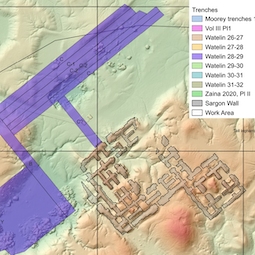 [/kish/images/chariots-fig1-large.jpg]
[/kish/images/chariots-fig1-large.jpg]1. Map of the OFME trenches made in 1928-1929, indicating Trench Y (2024). Source: State Board of Antiquities and Heritage, Iraq
These graves are considered the direct predecessors of the "Royal Tombs" at Ur, discovered in the same period (1922-1934) by Leonard Woolley and his team, but Kish's burials are less elaborate.
As with many of the discoveries made by the OFME between 1923-1933, "the cart-burials were so ill-recorded as to remain forever matter for debate" (Moorey 1978: 103). Mackay recorded 154 burials, 16 associated with animals, but many more graves were discovered and not described (Gibson 1972: 79). The bodies of the riders were found lying next to their carts, light vehicles presumably used for hunting and fighting. It is assumed that only privileged men were buried with their vehicle (Moorey 1978: 104).
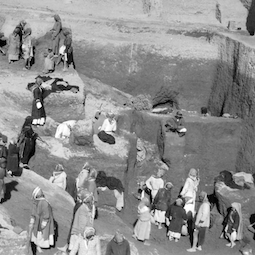 [/kish/images/chariots-fig2-large.jpg]
[/kish/images/chariots-fig2-large.jpg]2. "View north or northeast over Y trench" (undated). Source: OFME Photo Album, ANT 140B, p.64, Negative number 59633
The riders and animals were also buried with equipment and a variety of objects next to them, such as copper axe-heads, metal bowls similar to those found at Ur in the royal burials (Moorey 1978: 105), copper tools, saws, rein-rings, and red-painted jars.
The graves did surprise archaeologists for two reasons. First, although the burials contained many objects, none could be described as personal items. For example, there were no cylinder seals, unlike other simpler burials in Trench Y which contained personal belongings including cylinder seals. Second, except for the carts and their fittings, no precious metal and no jewellery accompanied the riders. The only difference between the Chariot Burials and other graves found in Trench Y is that the riders were accompanied by their equids and the carts they pulled. The Chariot Burials all resembled each other, so the individuals were probably contemporaries or near contemporaries buried at more or less the same time (Moorey 1978: 106).
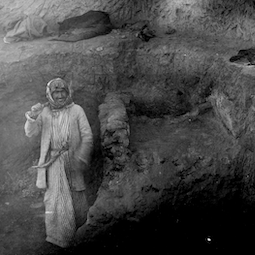 [/kish/images/chariots-fig-large.jpg]
[/kish/images/chariots-fig-large.jpg]3. "Dimna standing beside remains of furnace" (undated). Source: OFME Photo Album, ANT 140B, p.83, negative number 60153
When the OFME team started recovering parts of the carts (see Figure 3), they came across several fairly preserved wheels. These wheels were 50 cm in diameter, and had wooden pegs still pinned to them, with copper nails into the wheel's edge perhaps used to secure a leather "tyre" (see Figure 4 and Figure 5) (Moorey 1978: 108).
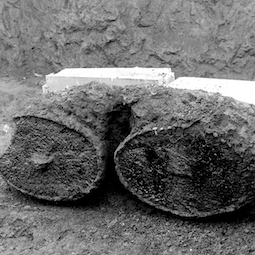 [/kish/images/chariots-fig4-large.jpg]
[/kish/images/chariots-fig4-large.jpg]4. "Two wheels of a four-wheeled chariot packed in plaster boxes for shipment" (undated). Source: OFME Photo Album, ANT 140B, p.117, negative number 60198
 [/kish/images/chariots-fig5-large.jpg]
[/kish/images/chariots-fig5-large.jpg]5. "Chariot showing copper nails in the rim and disc nature of wheels" (undated). Source: OFME Photo Album, ANT 140B, p.119, negative number 60207
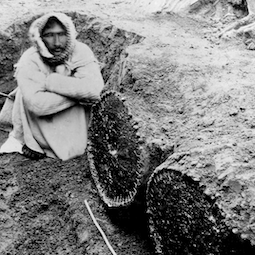 [/kish/images/chariots-fig6-large.jpg]
[/kish/images/chariots-fig6-large.jpg]6. "Dimna sitting beside left wheels of chariot" (undated). Source: OFME Photo Album, ANT 140B, p.108, negative number 60127
Post-excavation, most of the skeletal remains, as well as carts and other objects, were sent to the Field Museum in Chicago, where they still are today. But some of the human remains were transferred to the Natural History Museum in London, including the skulls of up to 65 individuals (Pestle, Torres-Rouf, Daverman 2023: 210; Molleson and Blondiaux 1994).
Today, if you visit Tell Ingharra, you will find that Trench Y is easily identifiable. Because this trench was so deep, it left a large rectangular-shaped marking on the ground, whitish from the salinization of the soil. Visitors should be particularly careful when walking in this area. Because Trench Y refilled naturally over time, its ground is soft and remains hazardous after rain.
15 Sep 2025
Nadia Aït Saïd-Ghanem
Nadia Aït Saïd-Ghanem, 'The Chariot Burials (Trench Y)', The Forgotten City of Kish • مدينة كيش المنسية, The Kish Project, 2025 [http://oracc.org/MoundsofKish/TellIngharra/ChariotBurials/]